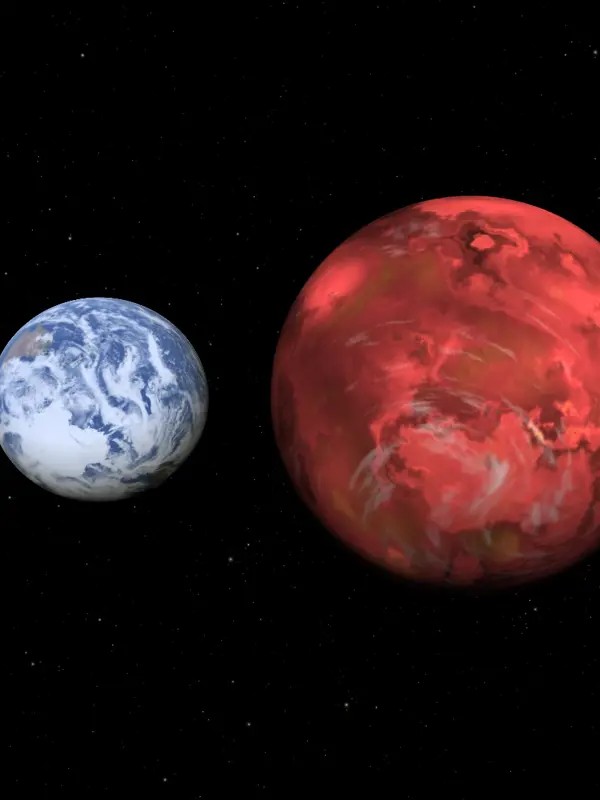Since the first discovery of exoplanets – planets orbiting other stars – scientists have been intrigued by the shortage of planets that are between about 1.5 and 2 times the size of Earth, the so-called “radius valley”, which separates two major planet populations – the super-Earths and the mini-Neptunes. A Chalmers-led team of scientists has studied one such planet, and found new clues to why they are so rare.

“TOI-733b is the most interesting exoplanet I have studied, since it is a planet in the radius valley, orbiting a Sun-like star. That is rare! There are several different theories on how these planets form and develop”, says Iskra Georgieva, Chalmers University of Technology.
Thanks to telescopes like NASA’s Kepler and TESS (Transiting Exoplanets Survey Satellite), and many other instruments, astronomers have been able to study thousands of planets orbiting around other stars. By measuring the planets’ sizes and masses, they have been surprised at how different from our Solar System other planetary systems can be.
The further out the planet is from the star, the harder it is to detect.

Chalmers astronomer Iskra Georgieva led a study of a system discovered by TESS, published recently in the journal Astronomy & Astrophysics. The team were able to confirm a planet with unusual characteristics, at a distance of 245 light years.
Most exoplanets are impossible to observe directly, since the light of the star drowns out all light from the typically much smaller planets in the system. But by using changes in the light from the star, astronomers can use several methods to detect and observe exoplanets. The two most common ones are the transit method and the radial velocity method. The former detects recurring drops in the brightness of a star every time a planet passes – or transits – in front of it; the latter relies on the Doppler shift of the spectral lines of the light emitted from a star (red- and blue-shift), which can tell us if the mass of another body (such as a planet) is tugging at the star.
Both methods are most successful in cases when the planet is large and/or close to the system’s star.
“A planet in a wider orbit will tug less at the star and will also transit less often. So, the reasons are different, but the effect is the same: the further out the planet is from the star, the harder it is to detect”, says Iskra Georgieva, who is part of a large team of exoplanet researchers called Kesprint.

Has TOI-733b lost its atmosphere? if so, how?
The exoplanet in question was first discovered by TESS, and is called TOI-733b. It is 245 light years away , almost twice the size of Earth, and orbits its star in 4.9 days. The researchers’ measurements, models and calculations suggest that if the planet ever had an atmosphere of light elements like hydrogen and helium, it has most likely lost it.
A planet can lose its atmosphere in several ways. The two most common mechanisms that describe such a process are photo-evaporation, where radiation from a nearby star evaporates the atmosphere, or core-powered mass loss, where geothermal heat from the planet’s core is being radiated out. Photo-evaporation is the faster mechanism of the two and takes place while the star and system are relatively young.
“We think that planets like TOI-733b represent a critical size in planet formation. Planets that reach this size quickly attract thick atmospheres of hydrogen and helium gas, and balloon up into gaseous planets, like Neptune. While planets smaller than this limit can’t hold on to such an atmosphere and therefore remain primarily rocky, with mostly thinner envelopes. And if they are close to their star, which in turn emits the right amount and kind of radiation, the planets’ atmospheres could be stripped away by the star. This appears to be the case for TOI-733b.”, Iskra Georgieva explains.
How the atmosphere is lost is a key question in planet evolution and the object of several ongoing research programs, specifically focusing on young stars, since the photo-evaporation process should occur early in a star system’s life within the first billion years, or so.
“Do these planets lose their atmospheres in one of the above-described ways? Can both processes occur, or is one more dominant? How often do planets of this size end up like TOI-733b? There are a lot of questions left to answer!”, says Iskra Georgieva.
Exoplanets are the best of two worlds
These are exciting times for exoplanet research, and for Iskra herself: she recently defended her Ph. D. thesis.
“We keep discovering more and more of these mysterious planets. We can’t go there with the technology and physics we have today, they are not within our reach even if we travel for several lifetimes, we can’t really see what they look like. They inspire many questions, not least ‘Could there be life there?’”
Even though life on TOI-733 b is unlikely, for Iskra, planets are more relatable than other hot topics in astronomy, like black holes, dark matter or the big bang.
“We know planets. We can see most of the solar system planets in the sky with the naked eye, and we even live on a planet ourselves! To me, exoplanets are the best of two worlds – mysterious, yet tangible”, says Iskra Georgieva.